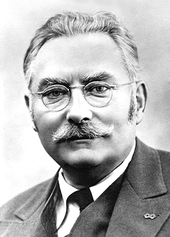Ludwig Schunk
Ludwig Schunk (born May 1, 1884 in Frankfurt am Main ; † May 10, 1947 in Heuchelheim near Gießen ) was a German manufacturer and co-founder of the company Schunk and Ebe oHG.
Schunk und Ebe oHG was founded in 1913 as a factory for the production of carbon brushes for dynamos and electric motors in Fulda , Hesse, and moved to Heuchelheim near Gießen in 1918. To date, the company has developed into a global technology group of the Schunk Group .
Ludwig Schunk's ancestors were firmly rooted in the Central Hesse region and had been running a nail forge in Büdingen for several generations since the middle of the 18th century . His grandfather still practiced this craft. As the youngest of three children, Ludwig Schunks 'father probably saw no opportunity to take over the parents' workshop and moved to Frankfurt am Main , where he worked, among other things, as a worker in a graphic arts establishment. Ludwig Schunk grew up as the youngest of two children in modest circumstances. Nevertheless, his family made it possible for him to attend a middle school for eight years, which Schunk completed with great success.
From 1898 to 1901 Ludwig Schunk did a commercial apprenticeship in an import company in the leather machine industry based in Frankfurt am Main and Boston, USA. Following his training, Schunk worked in his training company until April 1, 1903. Schunk gained further professional experience as a clerk in the purchasing department of an aniline and aniline paint factory in Offenbach am Main . In 1905, Schunk decided to go to France to further develop his language skills and his “world knowledge”. Schunk mastered the two world languages English and French and was able to find a job as head of foreign correspondence in a company in the electrical industry near Paris.
A six-year stay abroad followed, during which Ludwig Schunk got to know the manufacture of carbon brushes for electrical machines. The future prospects of this industry prompted him to set up his own business shortly after his return to Germany.
In 1913, at the age of 29, he founded the carbon brush factory Schunk & Ebe oHG in Fulda together with the technician and mechanical engineer Karl Ebe, who also had experience in the carbon industry. Karl Ebe died just a year after the company was founded.
In 1918 Ludwig Schunk relocated the rented company from Fulda to Heuchelheim near Gießen, where he was able to acquire the former excursion restaurant "Windhof", which had sufficiently large rooms to set up production facilities. The establishment of the first agencies in various major German cities and the establishment of the export business took place in this early period.
Like his successors later, Ludwig Schunk endeavored to expand and secure his company by diversifying into related technology areas. In 1923 he bought a carbon brush holder factory and integrated it into his Heuchelheim company. In 1932 the production of sintered bearings started. The carbon range had previously been expanded to include products for mechanical applications. With the increasing depreciation of the Reichsmark and the associated strong inflationary tendencies, Schunk was looking for new sales areas in foreign markets, from which stable foreign exchange flowed. By promoting the export business, he succeeded in avoiding the loss of the company's assets.
In line with his social attitude, Ludwig Schunk had already taken the initiative in 1940 to found a support organization whose statutory objectives were to provide voluntary one-off or ongoing support to employees, former employees or their relatives in the event of need, invalidity or old age. The beneficiary should provide old-age pensions, widow's and orphan's pensions, or death grants.
Ludwig Schunk had no children. His wife, who helped build the company, died early. The heirs of his late partner had been compensated by him so that he was the sole owner of the company's assets. As early as 1938 he decreed in his will that these company assets should be used for the service of the employees. He specified this in a supplementary will in 1942 and at the same time appointed the support institution he had founded as heir. According to his own statements, the model for Schunk was the Zeiss Foundation in Jena.
Between 1936 and 1945, Ludwig Schunk held various public offices. Among other things, Schunk has been head of the “Coal and Brushes Section” since December 1936 , one of 24 departments in the electrical industry business group. Schunk was denied entry to the company premises by the American military authorities after 1945 and the company was placed under fiduciary management. However, in the subsequent proceedings, Ludwig Schunk was rehabilitated.
In 1947, Ludwig Schunk, whose health had been unstable from his youth, died at the age of 63 as a result of heart failure. As ordered by him, after his death the support facility became the heir to the company assets of the Schunk & Ebe company.
After the death of Ludwig Schunk, the company Schunk & Ebe GmbH was founded, whose shares were now held by the support institution according to the will of the testator. As the current owner of the capital, it was called the Ludwig-Schunk-Gedächtnisverein eV and, since 1989, the Ludwig-Schunk-Foundation .
literature
- Kauer Jens: Schunk & Ebe. Children's days of a global corporation 1913–1947. Gießen 1995 (published by the Oberhessischer Geschichtsverein Gießen eV)
Web links
| personal data | |
|---|---|
| SURNAME | Schunk, Ludwig |
| BRIEF DESCRIPTION | German manufacturer and co-founder of Schunk und Ebe oHG |
| DATE OF BIRTH | May 1, 1884 |
| PLACE OF BIRTH | Frankfurt am Main |
| DATE OF DEATH | May 10, 1947 |
| Place of death | Heuchelheim near Giessen |
